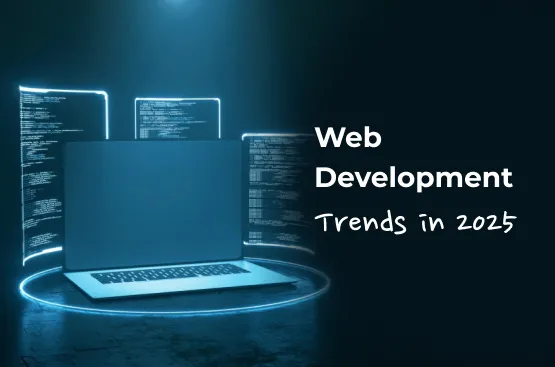
The web development landscape is constantly evolving, with new technologies and frameworks shaping the future of online experiences. As we move into 2025, businesses and developers need to stay ahead of the curve by adopting the latest trends that enhance performance, user experience, and security.
In this blog, we’ll explore the top web development trends to watch in 2025 and how they will impact the industry.
1. AI-Powered Development
Artificial Intelligence (AI) is revolutionizing web development by automating tasks, improving user interactions, and personalizing experiences. In 2025, expect AI to play a bigger role in:
✅ AI-powered chatbots & virtual assistants – Enhancing customer support with natural language processing (NLP).
✅ AI-generated code – Tools like GitHub Copilot and OpenAI Codex will streamline development.
✅ AI-driven UX design – Predicting user behavior to create more personalized experiences.
As AI continues to advance, businesses leveraging AI-driven development will gain a competitive edge.
2. Voice Search Optimization
With the rise of smart assistants like Alexa, Siri, and Google Assistant, voice search is becoming a crucial part of web development. In 2025, websites will need to be optimized for:
🔹 Conversational queries – Structuring content to match natural speech patterns.
🔹 Long-tail keywords – Focusing on phrases people commonly use in voice searches.
🔹 Schema markup – Enhancing search engine visibility with structured data.
Websites that prioritize voice search optimization will improve their rankings and user accessibility.
3. Progressive Web Apps (PWAs) Growth
Progressive Web Apps (PWAs) offer a seamless mobile experience without requiring users to download an app. In 2025, PWAs will continue to dominate due to:
📌 Faster load times – PWAs load instantly, even in low-network conditions.
📌 Offline accessibility – Allowing users to access content without an internet connection.
📌 Improved engagement – Offering app-like experiences in a browser.
Brands like Twitter, Starbucks, and Uber are already using PWAs, and we can expect more businesses to follow suit.
4. Web 3.0 and Blockchain Integration.
Web 3.0 is set to redefine web development by making the internet more decentralized, secure, and user-controlled. Key aspects of Web 3.0 in 2025 include:
🔹 Decentralized applications (dApps) – Built on blockchain for greater security and transparency.
🔹 Smart contracts – Automating transactions without intermediaries.
🔹 Improved data privacy – Giving users more control over their personal data.
With blockchain technology becoming more mainstream, businesses adopting Web 3.0 principles will enhance trust and security.
5. No-Code & Low-Code Development
The demand for web development is growing, but not everyone is a coding expert. That’s where no-code and low-code platforms come in. In 2025, more businesses will use:
✅ Drag-and-drop builders – Platforms like Webflow, Bubble, and Wix will simplify development.
✅ Pre-built integrations – Allowing faster deployment of web applications.
✅ AI-powered automation – Enabling non-technical users to build functional websites.
These platforms will democratize web development, making it accessible to a wider audience.
6. Motion UI & Micro-Interactions
User experience (UX) is at the core of web development, and in 2025, Motion UI will take center stage. This trend includes:
🎨 Smooth animations – Engaging users with interactive elements.
🎨 Micro-interactions – Small design details that provide feedback, like button hover effects.
🎨 Parallax scrolling – Creating a dynamic and immersive experience.
These design elements enhance usability and keep visitors engaged longer.
7. Cybersecurity Enhancements
As cyber threats continue to rise, web security is more important than ever. In 2025, businesses will focus on:
🔐 Multi-factor authentication (MFA) – Strengthening login security.
🔐 Zero-trust architecture – Verifying every request before granting access.
🔐 AI-driven security – Detecting and preventing threats in real time.
A secure website not only protects user data but also builds trust with customers.
8. Augmented Reality (AR) & Virtual Reality (VR) Experiences
The future of web development includes immersive experiences powered by AR and VR. In 2025, we’ll see:
🕶️ AR-powered eCommerce – Allowing customers to visualize products in real life before buying.
🕶️ VR training & simulations – Helping businesses train employees in a virtual environment.
🕶️ Interactive storytelling – Enhancing engagement through 3D visuals and interactive content.
As AR and VR become more accessible, businesses will integrate these technologies into their web experiences.
9. Edge Computing for Faster Performance
Edge computing reduces latency and speeds up websites by processing data closer to the user. In 2025, this trend will:
⚡ Improve website load times – Reducing delays for users worldwide.
⚡ Enhance IoT integration – Making smart devices more responsive.
⚡ Reduce server load – Distributing processing across multiple locations.
Edge computing will be essential for businesses looking to optimize performance.
10. API-First Development
As websites and applications rely more on integrations, API-first development will be a key trend in 2025. This approach:
🔹 Speeds up development – Allowing developers to build front-end and back-end separately.
🔹 Enables better scalability – Making it easier to integrate new features.
🔹 Enhances cross-platform compatibility – Ensuring smooth interactions between different services.
With APIs powering modern applications, businesses will prioritize API-first strategies.
Final Thoughts
The future of web development in 2025 is exciting, with AI, PWAs, Web 3.0, AR/VR, and cybersecurity taking center stage. Businesses and developers who embrace these trends will stay ahead of the competition, offering faster, smarter, and more secure web experiences.